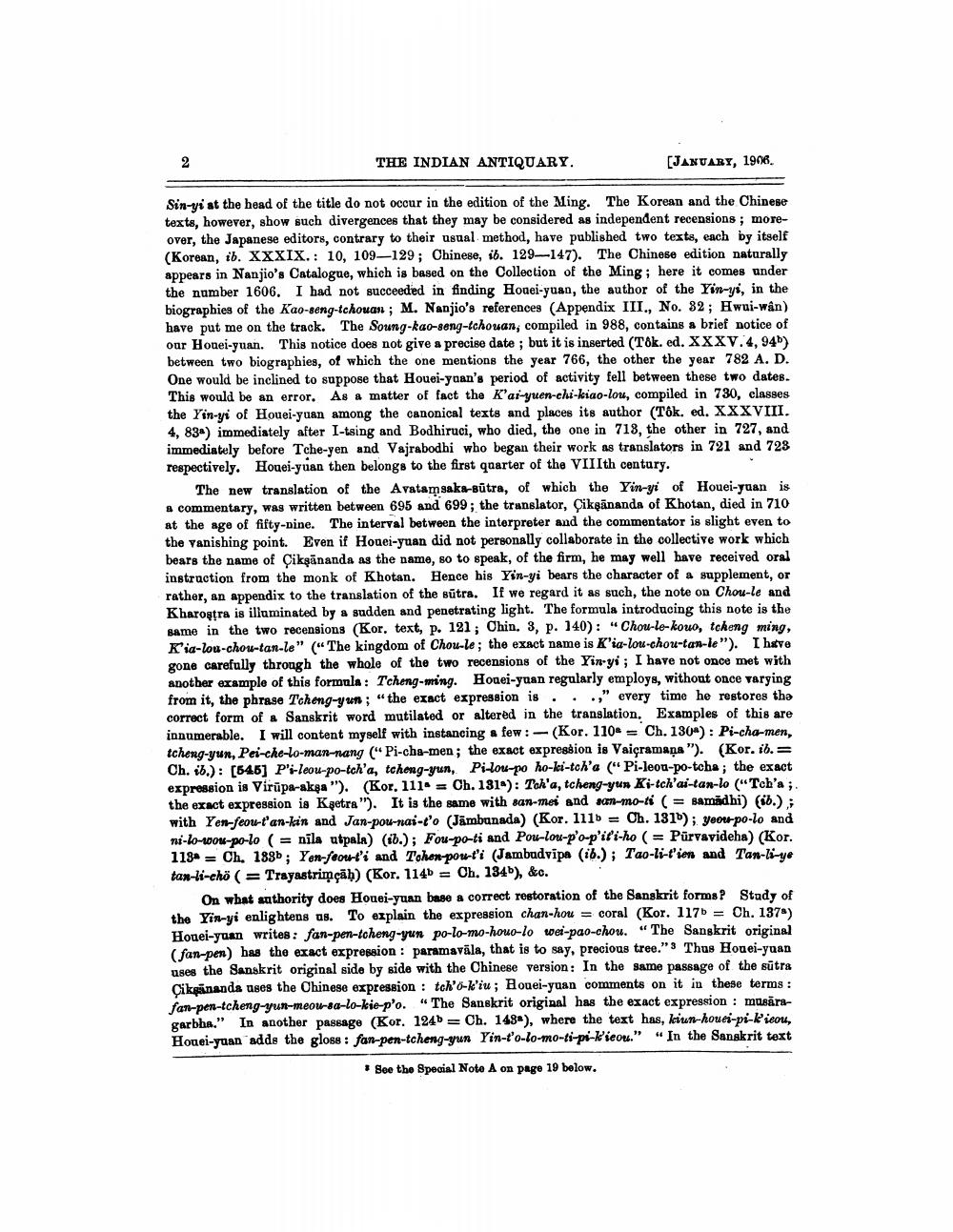Book Title: Indian Antiquary Vol 35 Author(s): Richard Carnac Temple Publisher: Swati Publications View full book textPage 8
________________ THE INDIAN ANTIQUARY. (JANUARY, 1906. Sin-yi at the head of the title do not occur in the edition of the Ming. The Korean and the Chinese texts, however, show such divergences that they may be considered as independent recensions ; moreover, the Japanese editors, contrary to their usual method, have published two texts, each by itself (Korean, ib. XXXIX.: 10, 109–129; Chinese, ib. 129–147). The Chinese edition naturally appears in Nanjio's Catalogue, which is based on the Collection of the Ming; here it comes under the number 1606. I had not succeeded in finding Hogei-yuan, the author of the Yin-yi, in the biographies of the Kao-seng-tchouan ; M. Nanjio's references (Appendix III., No. 82; Hwui-wan) have put me on the track. The Soung-kao-seng-tchouan, compiled in 988, contains a brief notice of our Honei-yuan. This notice does not give a precise date ; but it is inserted (T8k. ed. XXXV. 4, 945) between two biographies, of which the one mentions the year 766, the other the year 782 A. D. One would be inclined to suppose that Houei-yaan's period of activity fell between these two dates. This would be an error. As a matter of fact the K'ai-yuen-chi-kiao-lou, compiled in 730, classes the Yin-yi of Houei-yuan among the canonical texts and places its author (T6k. ed. XXXVIII. 4, 834) immediately after I-tsing and Bodhiruci, who died, the one in 713, the other in 727, and immediately before Tche-yen and Vajrabodhi who began their work as translators in 721 and 728 respectively. Hogei-yuan then belongs to the first quarter of the VIIIth century. The new translation of the Avatamsaka-būtra, of which the Yin-yi of Houei-yuan is commentary, was written between 695 and 699; the translator, Çikşānanda of Khotan, died in 710 at the age of fifty-nine. The interval between the interpreter and the commentator is slight even to the vanishing point. Even if Houei-yuan did not personally collaborate in the collective work which bears the name of Çikşānands as the name, so to speak, of the firm, he may well have received oral instruction from the monk of Khotan. Hence his Yin-yi bears the character of a supplement, or rather, an appendix to the translation of the sūtra. If we regard it as such, the note on Chou-le and Kharogtra is illuminated by a sudden and penetrating light. The formula introducing this note is the same in the two recensions (Kor, text, p. 121; Chin. 3, p. 140): "Chou-le-kouo, tokeng ming, K'ia-lou-chow-tan-le" ("The kingdom of Chou-le; the exact name is K'ia-lou-chou-tan-le"). I have gone carefully through the whole of the two recensions of the Yin-yi ; I have not once met with another example of this formula: Tcheng-ming. Hogei-yuan regularly employs, without once varying from it, the phrase Tcheng-yun; "the exact expression is ...," every time he restores tha correct form of a Sanskrit word mutilated or altered in the translation, Examples of this are innumerable. I will content myself with instancing a few :-(Kor. 110 - Ch. 1304): Pi-cha-men, tcheng-yun, Pei-che-lo-man-nang ("Pi-cha-men; the exact expression is Vaiçramaņa"). (Kor. ib.= Ch. ib.): (545] P'i-leou-po-tch'a, tcheng-yun, Pi-lou-po ho-ki-tch'a ("Pi-leon-po-teha; the exact expression is Virūpa-akşa"). (Kor. 111* = Ch. 131*): Tak'a, tcheng-yun Ki-tch'ai-tan-lo ("Tch'a; the exact expression is Kşetra"). It is the same with san-mes and sun-mo-ti (= samadhi) (ib.); with Yon-feou-t'an-kin and Jan-pou-nai-t'o (Jämbunada) (Kor. 111b = Oh. 1310); yeon-po-lo and ni-lo-wow-po-lo ( = nila atpala) (ib.); Fou-po-ti and Pou-lou-p'o-p'it'i-ho (= Pürvavideha) (Kor. 118* = Ch. 188b; Yon-feourt'i and Tohon-pou-ti (Jambudvipa (ib.); Tao-li-t'ien and Tan-li-ye tax-i-chõ (=Trayaotrime&h) (Kor. 114b = Ch. 1849) &e. On what authority does Houei-yuan base a correct restoration of the Sanskrit forms? Study of the Yin-yi enlightens us. To explain the expression chan-hou = coral (Kor. 1176 = Ch. 137) Hogei-yuan writes: fan-pen-tcheng-yun po-lo-mo-houo-lo wei-pao-chou. "The Sangkrit original (fan-pen) has the exact expression : paramavāla, that is to say, precious tree." Thus Houei-yuan uses the Sanskrit original side by side with the Chinese version: In the same passage of the sutra Cikginanda uses the Chinese expression : tch'o-k'iu; Houei-yuan comments on it in these terms: fan-pen-tcheng-yun-meow-sa-lo-kie-p'o." The Sanskrit original has the exact expression : mosäragarbha." In another passage (Kor. 124b = Ch. 1482), where the text has, kiun-houei-pi-kicou, Houei-yaan adds the gloss : fan-pen-tcheng-yun Yin-to-lo-mo-ti-pi-Kieous.” “In the Sanskrit text See the Special Note A on page 19 below.Page Navigation
1 ... 6 7 8 9 10 11 12 13 14 15 16 17 18 19 20 21 22 23 24 25 26 27 28 29 30 31 32 33 34 35 36 37 38 39 40 41 42 43 44 45 46 47 48 49 50 51 52 53 54 55 56 57 58 59 60 61 62 63 64 65 66 67 68 69 70 71 72 73 74 75 76 77 78 79 80 81 82 ... 434
